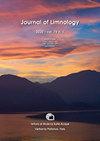Contemporary community composition, spatial distribution patterns, and biodiversity characteristics of zooplankton in large alpine Lake Sevan, Armenia
IF 1.1
4区 环境科学与生态学
Q4 LIMNOLOGY
引用次数: 0
Abstract
We studied the quantitative composition, spatial distribution, and temporal dynamics of the zooplankton community of the alpine Lake Sevan, Armenia, the largest surface water in the Caucasus region. This article is providing a long-term information and fills the research gap of multiyear data on zooplankton, as the previous research on zooplankton provided only snapshots of the community, and a consistent assessment over multiple years was missing. However, an initial mini-review of historical studies indicated that zooplankton biomass and fish abundance were undergoing large fluctuations, indicating the importance of top-down control. We analysed 239 samples from the period 2016-2019 from 32 sampling sites in Lake Sevan and recorded 37 species of meso- and macrozooplankton (Rotifers, Copepods, Cladocera). Biomass fluctuations were high with peaking biomasses in 2016 and lowest biomasses in 2018, yearly averaged biomass varied about one order of magnitude. Variability over time was hence much higher than spatial variability. The pelagic habitat at the deepest part of the lake showed the highest diversity and biomasses but contrasts between sampling sites remained smaller than changes from year to year or seasonally. Many samples were dominated by a single species, and these key species explain observed biomass dynamics to a wide extent. We applied hierarchical clustering in order to identify phenological groups that appear to show similar patterns of occurrence. This clustering resulted in 6 groups where of 5 groups just consisting of one single species and these 5 key species were the Cladocerans Daphnia magna, Daphnia hyalina, Diaphanosoma sp. as well as the calanoids Arctodiaptomus bacillifer and Acanthodiaptomus denticornis. The most important species in Lake Sevan’s zooplankton during the observation period was D. magna, which reached high biomasses in 2016 and 2017 but then suddenly almost disappeared in 2018 and 2019. When there were more D. magna present, the water became clearer, which was measured using Secchi depth. This shows that these large water fleas effectively controlled the amount of phytoplankton in the water. Daphnia magna, in turn, managed to dominate zooplankton community only during times of extremely low fish biomass indicating strong top-down control of this large Cladoceran by fish. Both observations together imply a strong trophic linkage between fish, zooplankton, and phytoplankton and provide evidence for trophic cascades in Lake Sevan. Besides the novel insights into zooplankton community dynamics of this unique lake of high socio-economical, cultural, and ecological importance, our study also points to potential management opportunities for eutrophication control by biomanipulation, as well as our investigation allows us to conclude that probably biotic factors were more important than abiotic factors in explaining the observed changes and dynamics within the plankton community.亚美尼亚塞万湖大型高山浮游动物的当代群落组成、空间分布模式和生物多样性特征
我们研究了高加索地区最大的地表水亚美尼亚塞万湖浮游动物群落的定量组成、空间分布和时间动态。这篇文章提供了长期信息,填补了浮游动物多年数据的研究空白,因为之前的浮游动物研究只提供了群落的快照,缺乏多年的一致性评估。然而,对历史研究的初步小型回顾表明,浮游动物的生物量和鱼类的丰度正经历着巨大的波动,这表明自上而下控制的重要性。我们分析了 2016-2019 年期间塞万湖 32 个采样点的 239 份样本,记录了 37 种中型和大型浮游动物(轮虫、桡足类、栉水母)。生物量波动较大,2016 年生物量达到峰值,2018 年生物量最低,年平均生物量相差约一个数量级。因此,时间变异性远高于空间变异性。湖泊最深处的浮游栖息地显示出最高的多样性和生物量,但采样点之间的对比仍然小于年际或季节变化。许多样本由单一物种主导,这些关键物种在很大程度上解释了观察到的生物量动态。我们采用了分层聚类的方法,以确定似乎表现出相似出现模式的物候类群。这 5 个关键物种是桡足类的大型水蚤(Daphnia magna)、hyalina 水蚤(Daphnia hyalina)、Diaphanosoma sp.以及桡足类的大鳃鲃(Arctodiaptomus bacillifer)和齿鳃鲃(Acanthodiaptomus denticornis)。在观测期间,塞凡湖浮游动物中最重要的物种是D. magna,其生物量在2016年和2017年达到较高水平,但在2018年和2019年突然几乎消失。当 D. magna 出现较多时,水质变得更加清澈,这是用 Secchi 深度测量的结果。这表明这些大型水蚤有效地控制了水中浮游植物的数量。反过来,大型水蚤只有在鱼类生物量极低的时候才能主宰浮游动物群落,这表明鱼类自上而下地对这种大型梭形纲动物进行了强有力的控制。这两项观察结果共同表明,鱼类、浮游动物和浮游植物之间存在密切的营养联系,并为塞凡湖的营养级联提供了证据。除了对这个具有重要社会经济、文化和生态意义的独特湖泊的浮游动物群落动态有了新的认识外,我们的研究还指出了通过生物操纵控制富营养化的潜在管理机会,同时我们的调查还让我们得出结论,在解释浮游生物群落中观察到的变化和动态时,生物因素可能比非生物因素更重要。
本文章由计算机程序翻译,如有差异,请以英文原文为准。
求助全文
约1分钟内获得全文
求助全文
来源期刊

Journal of Limnology
地学-湖沼学
CiteScore
2.70
自引率
6.20%
发文量
12
审稿时长
3 months
期刊介绍:
The Journal of Limnology publishes peer-reviewed original papers, review papers and notes about all aspects of limnology. The scope of the Journal of Limnology comprises the ecology, biology, microbiology, physics, and chemistry of freshwaters, including the impact of human activities, management and conservation. Coverage includes molecular-, organism-, community-, and ecosystem-level studies on both applied and theoretical issues. Proceedings of workshops, specialized symposia, conferences, may also be accepted for publication.
 求助内容:
求助内容: 应助结果提醒方式:
应助结果提醒方式:


